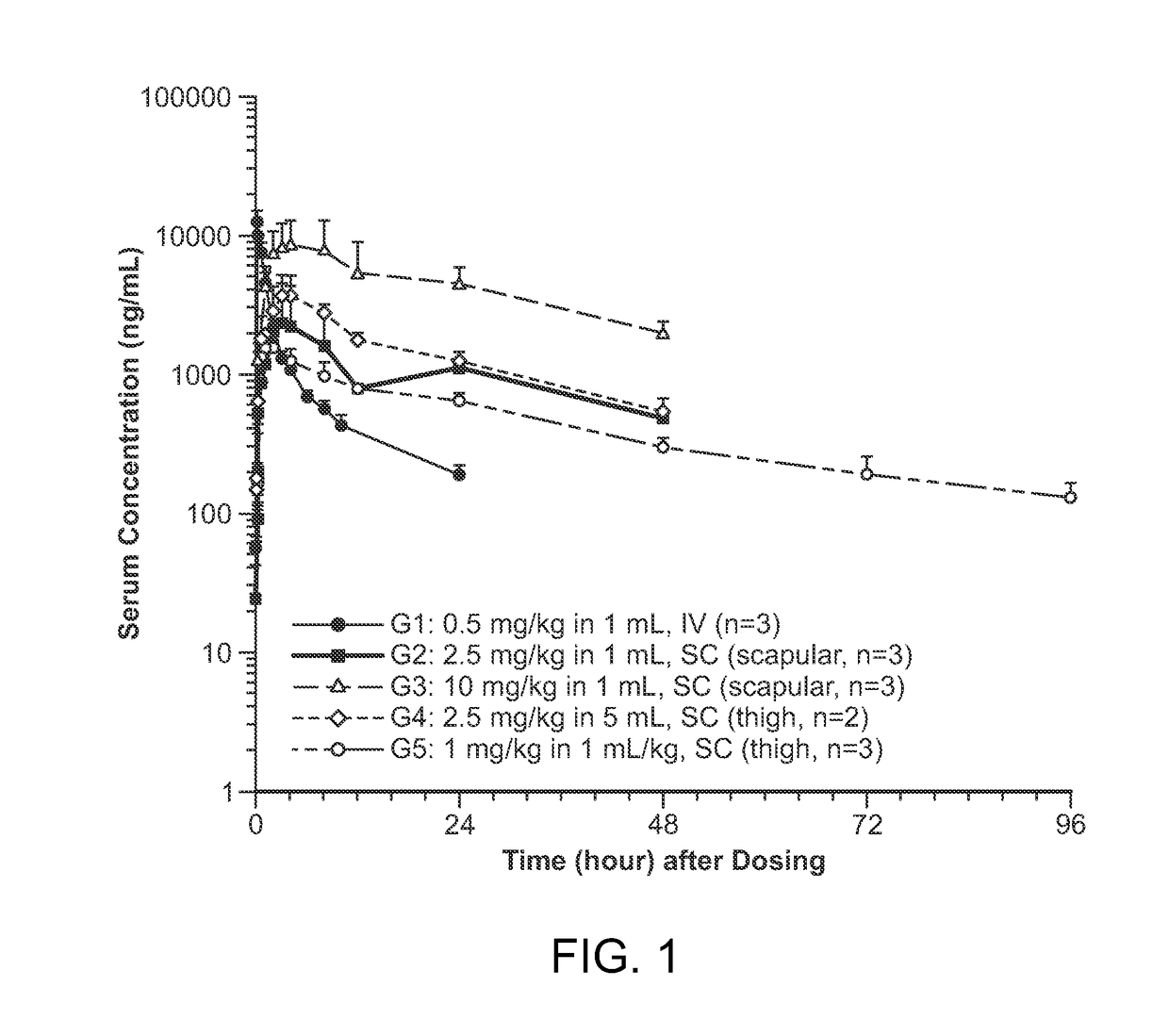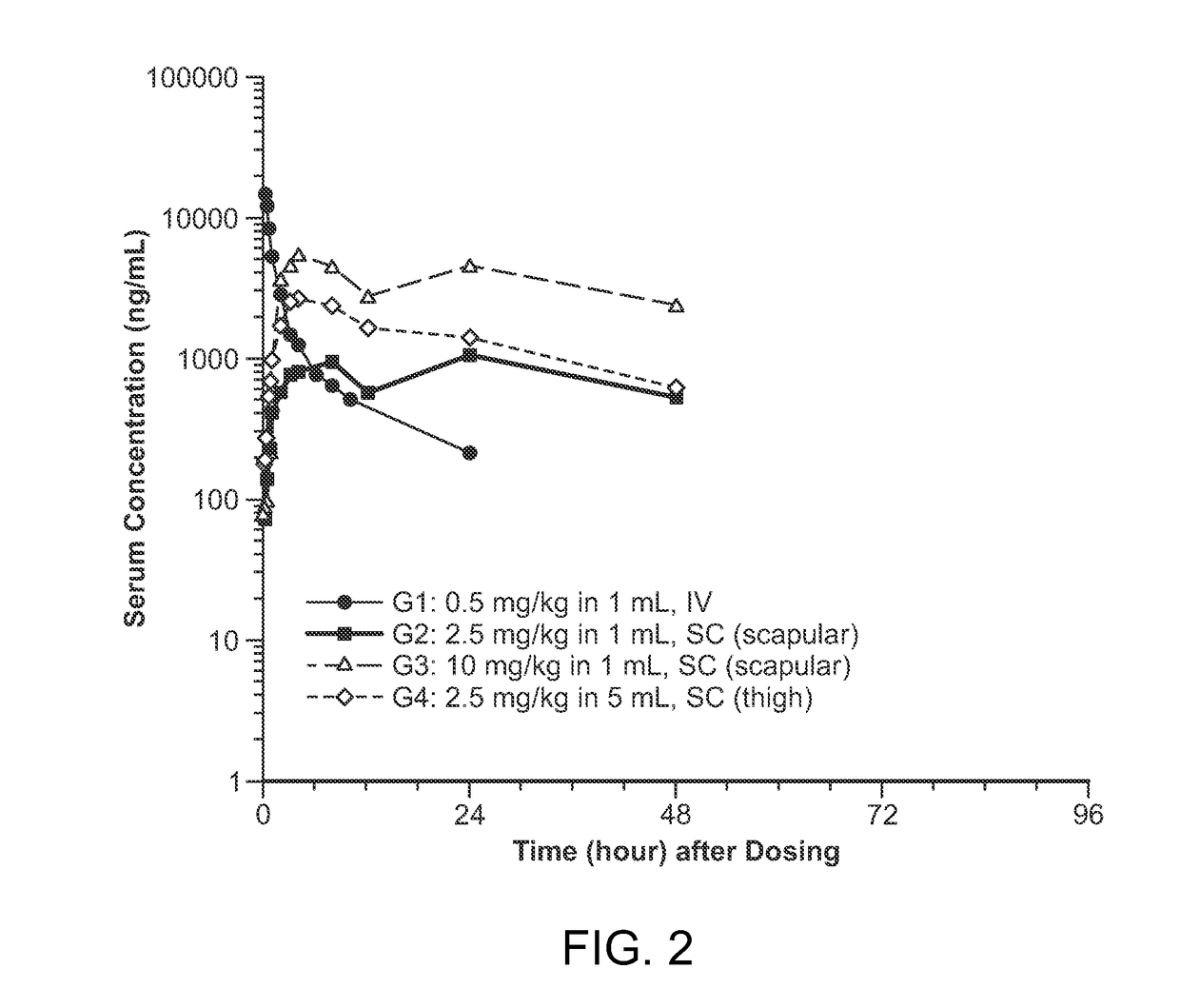Subcutaneous administration of iduronate-2-sulfatase
a technology of iduronate and sulfatase, which is applied in the field of subcutaneous administration of iduronate2sulfatase, can solve the problems of unsatisfactory patients and caregivers, and achieve the effects of improving the pharmacokinetic parameters of the replacement i2s protein, and improving the pharmacokinetic parameters
- Summary
- Abstract
- Description
- Claims
- Application Information
AI Technical Summary
Benefits of technology
Problems solved by technology
Method used
Image
Examples
example 1
IV and Subcutaneous (SC) Administration of Recombinant Iduronate 2-Sulfatase in Non-Human Primates (NHPs)
[0158]The purpose of the present example, was to perform a study to evaluate subcutaneous (SC) administration of a recombinant form of iduronate-2-sulfatase (rI2S). As part of the evaluation, bioavailability and other pharmacokinetic parameters were empirically determined following SC administration, in order to assess the overall effectiveness of the treatment in non-human primates.
[0159]In the current study, SC administration of rI2S was investigated to evaluate the efficacy of the approach, as compared to the traditional IV approach. As a result, one additional goal of the current study, is to use elucidate if subcutaneous administration is an equally effective route of administration; and using the data obtained from NHPs to extrapolate and predict conditions for SC administration in humans in order to design an effective therapeutic regimen.
Overview of the Experimental Model...
example 2
IV and Subcutaneous (SC) Administration of Recombinant Iduronate 2-Sulfatase in Mice
[0209]The purpose of the present example, was to perform a study to evaluate subcutaneous (SC) administration of a recombinant form of iduronate-2-sulfatase (rI2S). As part of the evaluation, pharmacokinetic and pharmacodynamic parameters were empirically determined following SC administration, using a mouse experimental model system. Such data may be used to help extrapolate and predict conditions for SC administration in humans in order to design an effective therapeutic regimen, while taking into consideration the drug's safety profile.
Experimental Parameters for Pharmacokinetic Evaluation
[0210]For the pharmacokinetic studies, three groups of three male mice were selected for evaluating the effectiveness of subcutaneous treatment of recombinant iduronate-2-sulfatase (rI2S) as compared to IV administration. Groups 1 through 3, consisted of three naïve male C57bl / 6 I2S knockout (IKO) mice treated wi...
example 3
IV and Subcutaneous (SC) Administration of Recombinant Iduronate 2-Sulfatase in Pig
[0229]The purpose of the present example, was to perform a study to evaluate subcutaneous (SC) administration of a recombinant form of iduronate-2-sulfatase (rI2S). As part of the evaluation, pharmacokinetic parameters were empirically determined following SC administration, using a Gottingen minipig experimental model system. Such data may be used to help extrapolate and predict conditions for SC administration in humans in order to design an effective therapeutic regimen, while taking into consideration the drug's safety profile.
Experimental Parameters for Pharmacokinetic Evaluation
[0230]For the pharmacokinetic study, four groups of three male pigs were selected for evaluating the effectiveness of subcutaneous delivery of recombinant iduronate-2-sulfatase (rI2S) as compared to IV administration. Groups 1 through 3 consisted of three naïve male Gottingen minipigs treated with a single IV or subcutane...
PUM
| Property | Measurement | Unit |
|---|---|---|
| volume | aaaaa | aaaaa |
| concentration | aaaaa | aaaaa |
| concentration | aaaaa | aaaaa |
Abstract
Description
Claims
Application Information
 Login to View More
Login to View More - R&D
- Intellectual Property
- Life Sciences
- Materials
- Tech Scout
- Unparalleled Data Quality
- Higher Quality Content
- 60% Fewer Hallucinations
Browse by: Latest US Patents, China's latest patents, Technical Efficacy Thesaurus, Application Domain, Technology Topic, Popular Technical Reports.
© 2025 PatSnap. All rights reserved.Legal|Privacy policy|Modern Slavery Act Transparency Statement|Sitemap|About US| Contact US: help@patsnap.com



